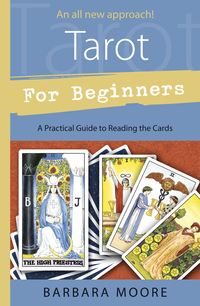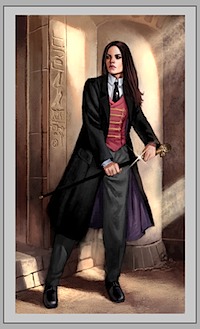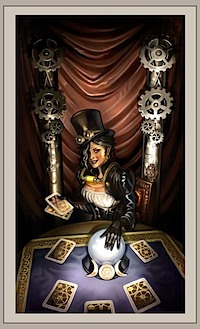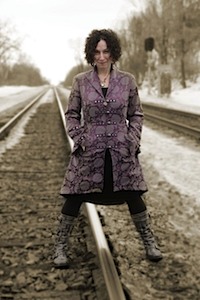By Terri C.
Barbara Moore is best known for giving the voice to many of our favorite Tarot decks, including The Shadowscapes Tarot and The Gilded Tarot. She has been involved with Tarot in both her personal and professional life for more than two decades. She has been active with the American Tarot Association and has spoken at conferences in the United States. Barbara has studied with renowned Tarot scholars Mary K. Greer and Rachel Pollack. She has shared her love of the Tarot with many of us through her written word and in-person classes. We were thrilled that she was able to take time out of her busy schedule to talk to us!
Tarot Reflections: Would you tell us when and how you got your start in divination?
Barbara Moore: When I was a kid, growing up in the suburbs of Detroit, I remember wishing for things or wanting things. I’d sit on the couch and stare out the window thinking things like, “If three red cars drive by in the next 10 minutes, then [insert wish] will come true.”
Years later, when I was in college, I bought a Celtic Tree Oracle. I thought it lovely and had such high hopes but was always a little disappointed because the answers felt so vague. A few years after that, I discovered Tarot. As soon as I felt the cards in my hands, I knew this was the tool for me.
TR: How has using the Tarot affected your life?
BM: Perhaps the better question is how has it not shaped my life? For the last 14 years at least, Tarot has been at the core of my professional life via my work for Llewellyn, Lo Scarabeo, and my own writing, deck creation, readings, and teachings.
As my spiritual life evolved, Tarot remained a constant. Its fundamental structure and traditional meanings and symbols were a solid framework that I could hold onto as I explored different beliefs and practices. It provided a safe space that allowed me to explore and grow.
TR: What do you like best about Tarot? What do you find most amazing?
BM: When I first discover Tarot, I reveled in the way it wove together so many of my existing interests: art, history, philosophy, mysticism, religion, spirituality, psychology, mythology. Exploring any one of those areas would take a lifetime. So tie them all together in a beautiful package and I’ll be content for years. But it doesn’t end there…because there are more decks, one more beautiful than the next or more intriguing and compelling or more challenging. It is a world steeped in fascinating topics and a community peopled with the more creative and brightest I’ve ever known. The world of Tarot has become the world in which I live my life. I think Tarot. I create Tarot. I shuffle Tarot and create my life. What to do I like best or find most amazing about Tarot? Life. Everything. I cannot imagine Tarot as a framework for my life. It’s like saying “I’m bored.” I cannot imagine being bored.
TR: What's your number one tip for better Tarot readings?
BM: Make sure your beliefs about tarot are sorted out before you start. In my book Tarot for Beginners I spend quite a bit of time on that idea. Everything about your Tarot practice should be grounded in and reflect your beliefs. Once you are clear on what you think about the cards (as a whole and each card individually), what a Tarot reading can and should accomplish, and your role as a reader, then everything else flows easily from that foundation.
The number two tip is trust. Trust the cards and trust yourself. But you cannot do that until you are clear about your beliefs.
The number three tip is practice and experience. Reading and learning is great and an important part of becoming a good reader. But you will learn things (about yourself, about the cards, about people, about life) by doing readings that you can never learn in books or classes.
TR: When you write a companion book for a deck, how much input do you receive and/or want from the artist of the deck?
BM: It varies greatly from project to project. With some, such as Gilded and Mystic Faerie, I got basically no input from the artists. The artist for Mystic Dreamer provided notes on each of the cards that I consulted. English is not her native language, which is one reason I helped with that book.
The projects that I’m working on now (or have recently finished) are different. I am directing the artist rather than just giving voice to the cards. This is much more exciting to me and feels more like I’m creating a deck. Instead of me giving voice to the cards, the artist is giving shape to my words.
The Pagan Cats Tarot is my first deck that I actually created in this way. It is published under a pen name, Magdelina Messina, because at the time I was working on several projects for Lo Scarabeo, which were all planned to be released in the same catalog. They didn’t want most of their catalog to have my name all over it, so we agreed that I’d use a pen name. I am rather sorry now, as the production schedules got revised making the reason unnecessary and I have to say that I am ridiculously pleased with how the Pagan Cats turned out.
I am currently working on four decks. With three of these, I am directing the art and one is a collaborative effort. The collaboration, with Julia Jeffries on a deck tentatively titled The Faerie Realms Tarot, will be a unique experience and I am looking forward to it.
TR: How many hours a day to you spend writing?
BM: Depends on the day. And it depends on what you mean by “writing.” For me, writing includes more than the actual act of writing. Researching, reading, playing with my cards, talking with colleagues, outlining, thinking, meditating, and experimenting are all part of writing. Those activities are like the Wands, Cups, and Swords of writing. Pentacles is the actual writing.
So, in a way I spend almost every waking hour (oh, heck, maybe some sleeping hours, too) writing. But I do actually try to keep to a regular working week, Monday – Friday, about 7:30 – 4:30.
TR: As a writer, what other genres are you interested in?
BM: Ah, like almost every non-fiction writer, I dream of writing brilliant fiction. I notice that I can continue this answer by responding to your next question.
TR: Do you envision publishing any fiction, in the future?
BM: Yes. In 2009, I participated in NaNoWriMo for the first time. It was also my first attempt at fiction since elementary school. I did it, at first, to jump start my creativity and intuition with cards. I used Corrine Kenner’s Tarot for Writers and simply meant to explore the cards in a new way.
However, the characters I created were so fascinating that I have been thinking about them ever since. My “novel” needs a rewrite and has been hibernating for a long time. I have, however, scheduled some time this spring to polish it up and hope to offer it to agents during the summer.
TR: What advice would you offer an aspiring writer?
BM: Understand the publishing industry. Know your market and your audience. Study each publisher’s guidelines and follow them to the letter. Have realistic expectations.
TR: After writing so many companion books, what compelled you to write a book just for beginners?
BM: To be honest, Llewellyn asked me if I would write their new edition. The original edition, by P. Scott Hollander was a bit dated in terms of contemporary Tarot practices. I was honored to be asked. And after I got started, I was really excited about sharing my ideas about tarot freed from any particular deck.
I’ve always felt that my best strength is the ability to present complex information in a clear, simple making it easy for a beginner to grasp.
TR: What is your favorite part (chapter/card page, etc), of Tarot for Beginners?
BM: Oh, I have a few favorite bits. Like the paragraph on pp. 8 – 9:
From a game to secret occult teaching to Gypsy stereotypes to therapy, tarot has played many roles. Societies and individuals have looked into the mirror that is tarot, and the reflections have revealed changes in culture and in individuals. Through the years, tarot—sometimes called the “royal road”—followed a path rich with entertainment, mystery, wisdom, and beauty. And each of us who ever shuffle a deck take part in that ongoing journey, both shaping and being shaped by it.
Page 19: The tarot is a mirror, and a tarot reading is a reflection of one’s worldview, a glimpse of a belief system. This is true whether the reader and the querent are aware of it or not. However, we may as well be aware of our predispositions and use the tarot in a way that compliments them rather than works against them. By applying this practice of using the cards in a way that reflects our personal beliefs, we really can’t say we don’t believe in tarot cards. The tarot cards are just cards, after all. It is how we use them that matters.
However I do have two most favorite parts. The end of Chapter 2 (beginning on page 30) where I explain about the difference between prescriptive and descriptive interpretations is very important and part of what makes my approach unique. Also my approach to interpreting the court cards as described on page 22 and 222 I think is particularly interesting. To be honest, I am kind of surprised no one has yet mentioned that. Maybe it is not as useful or interesting as I think!
TR: What part of this book was the most challenging to write?
BM: The part on court cards. As a reader, you know the challenges involved with those cards, even for seasoned readers. I needed to find a way to approach them that made sense and was easy to understand. I think I managed it, but it was the hardest part, not so much to write (I find if I am clear in my thinking about something, the actual writing is always easy), but to come up with the approach.
TR: How did you choose which decks to use to illustrate your thoughts in Tarot for Beginners?
BM: I wanted to use the Rider as base, since most people these days begin there. I wanted to also to include two other decks based on that tradition so I could show the reader the similarities and differences so that they could learn to read whatever deck they happened to be using (well, as long as it followed the RWS tradition).
TR: You provide core meanings and then some, for each card, in your book along with what you refer to as “layers,” do you use all of the “layers” when you do your readings, or do you only use some of them? Ie. Reversals.
BM: Only some! At least consciously. After 20 years, I imagine some happen without me thinking about them.
Reversals, for example, I only use with some decks. I don’t really know why, but some decks seem to want me to incorporate reversals, but most don’t.
I usually always scan a reading, noting the suits that are there and that are absent. Also, I tend to always notice the numbers.
Relationships between the suits is dependent on the deck I’m using. I find that when I use the RWS, I pay more attention to this. Lately I’ve been using the Anna K Tarot almost exclusively and I find with that one, I am looking more at the story the cards tell (it’s a very narrative, evocative deck and not as “symbolic” as most) rather than looking for symbolic patterns. Reading this deck is so easy for me, I kind of feel like I’m cheating.
TR: You include many sources for more information or further study for your readers, do you have a particular favorite Tarot reference that stands above the others? If so, which is it?
BM: No, not really. I think selecting sources and reference books and books that take you deeper really depends on your approach and goals. I don’t think any one book is the best or right choice for everyone.
TR: I’ve read that you are currently teaching classes locally. Would you care to share some information about those classes?
BM: Sure. The details are on my website, so folks can go there for more information. I’m teaching Candle Magic, which has nothing to do with Tarot, but is something that I love and practice almost every day.
My two Tarot classes are actually spread-based. My Fool’s Journey class is not a generic review of the Fool’s Journey, but is based on an article written years ago by Rachel Pollack. The Fool’s Journey becomes the basis for a spread that uses only (and all) of the Major Arcana cards. It is a fascinating spread and one that I do about once a year for myself.
The other class is on Tarot spreads in general. I am currently finishing up a manuscript called Tarot Spreads for Beginners: Understanding, Using, and Creating Spreads. In the class we discuss the components of a spread, how they work together to shape interpretation, and how to modify or create your own spreads. It’s fast-paced and fun.
TR: Have you considered offering those via tele-class or via e-book format for those that do not have local access?
BM: I have. After I finish up some projects and loose ends, I hope to explore those possibilities more.
TR: What are you looking forward to this year?
BM: The Readers Studio! I am usually very excited about this conference, and this year more than ever. I’ve made some amazing friends on Facebook and cannot wait to connect with them in person at the RS. Also, you may have heard, I’m one of the three main stage speakers this year, so I’m totally terrified and incredibly excited. Plus, it is a great excuse to buy a new outfit, right?
TR: Do you have any upcoming projects that you would like our readers to know about?
BM: I already mentioned my upcoming book, Tarot Spreads for Beginners.
I am working on a unique project for Lo Scarabeo. They asked me to create a deck based on a title and a concept. The title is Book of Shadows Tarot. The concept is to make it a two-deck system.
This was really challenging and I finally decided to base it on the magical premise “as above, so below.” So the first deck, Book of Shadows, Volume 1 focuses on the theory of paganism and magical practices. It is definitely NOT a RWS deck and consequently was really fun to create. The second deck, Book of Shadows, Volume 2 is a RWS-based deck and shows how magic is used or reflected in everyday life. It’s a pretty clever system, if I do say so. It has been delayed, as there have been some issues with getting the art just right. But it is well on its way.
My most exciting project is The Steampunk Tarot. This is a deck I’ve been working on for about five years now. Mostly it was just kicking around in my brain. Then about two years ago, I wrote the script for the deck. Then I spent six months looking for an artist. When I found Aly Fell’s website (http://www.darkrising.co.uk/ ), I knew I found the perfect artist. I wrote to him and would you believe, he accepted the project! He is doing such an excellent job bringing my words to life. I have a feeling this will my magnum opus. It so fully reflects my beliefs about life and tarot…plus it is absurdly beautiful. Folks can learn more on my website or at http://steampunktarot.wordpress.com/
TR: How can our readers learn more about you?
BM: My website: http://practicaltarotreadings.com/
Also, my Facebook page (which I think is wide open and viewable to anyone, so people can check me out without “friending” me): http://www.facebook.com/barbara.moore.tarot
I do love Facebook and welcome all friends. People should be warned, though, that I sometimes post a lot, so that could get annoying. Also, I mix my personal and professional lives because honestly, I cannot see a clear distinction between the two. They are very entwined.



